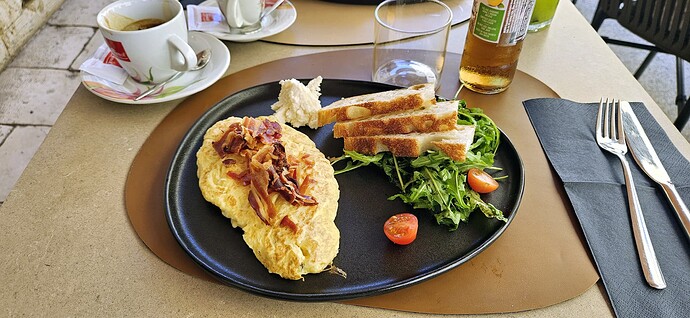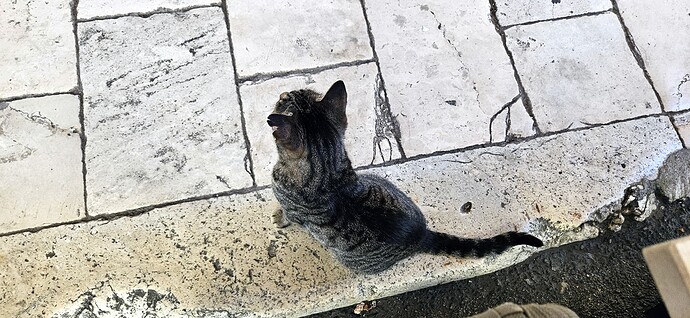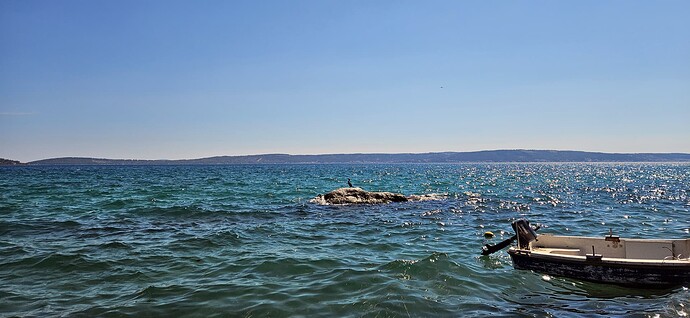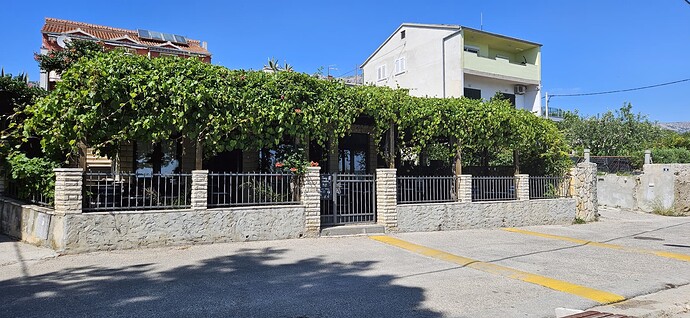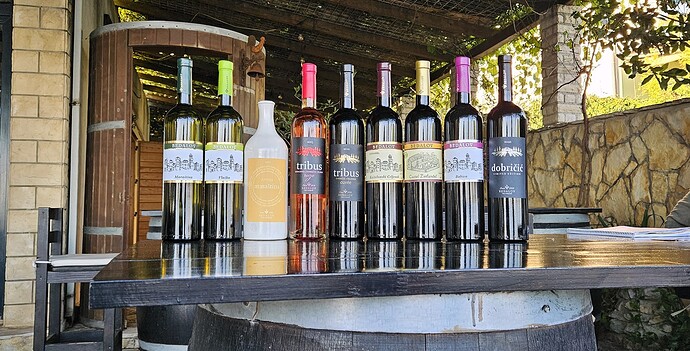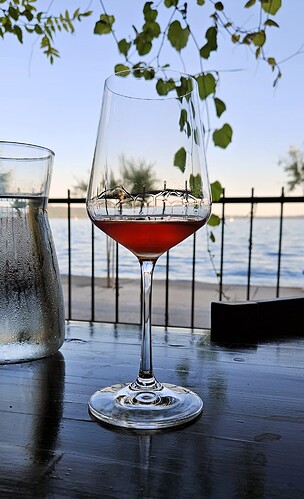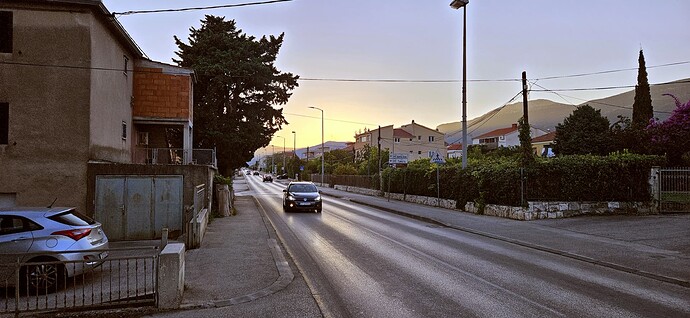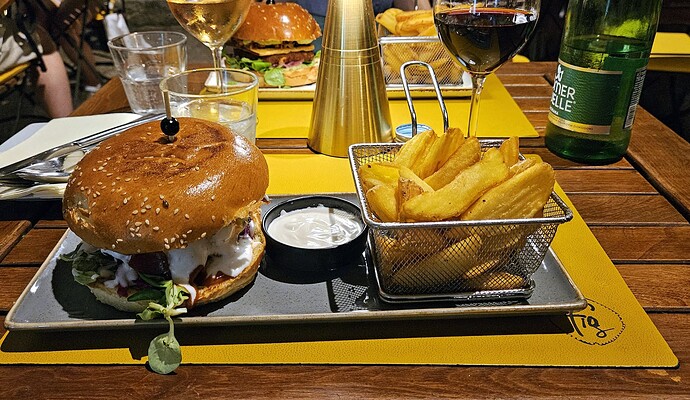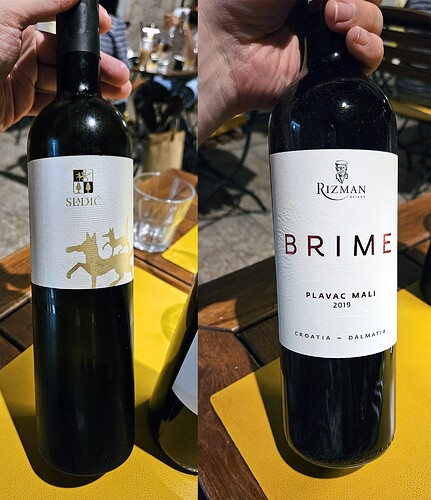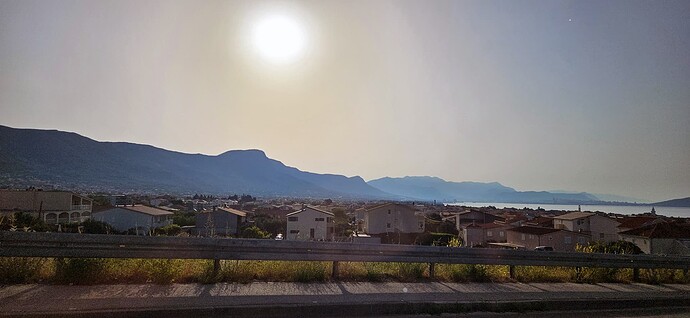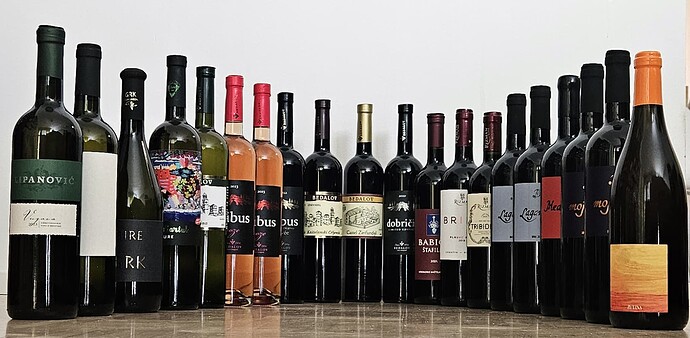I think that Spain is the outlier in this category. I love Spanish food from north to south, but its overly rich nature overwells me after a week or so.
I think that Mediterranean cuisine is more like a continuum. There’s rather little common ground in, say, Spanish and Lebanese cuisine - well, apart from the olive oil. However, Spanish cuisine is much closer to the southern France cuisine, Croatian to Italian, Greek to Turkish, and so on.
And of course there are numerous of different local cuisines within one country, naturally.
I’ll need to plan a Mediterranean trip across all those countries just to verify your theory ![]()
Sure, if you need bad excuses! ![]()
Also, never expected anyone from Argentina to describe Spanish cuisine as rich! ![]()
Bless you all, lovely people… I mean, notwithstanding the fact that I’ve spent most of my life elsewhere, I am and remain originally Croatian, and I wish I could muster half the amount of enthusiasm for Croatia’s wine, food or, indeed, tourism that most of you apparently can ![]()
![]()
![]()
How do we know you’re really Croatian?
Sure, your first name starts with 5 consonants but there aren’t any “j” anywhere! ![]()
That’s just the point, though, I’m originally Croatian, but not “really” Croatian ![]()
![]()
![]()
I am in Croatia right now, though, and drinking Croatian wine, so I second Otto’s feelings and thoughts on Rizman’s Syrah. Komarna is a funny place, it’s almost like warm-climate and cool-climate at the same time, tends to produce wines that are probably quite elegant for the latitude and the broader setting. Although, not all have Rizman’s great touch… As for Syrah, for people who have cut their teeth on France’s great standard-setting wines, I’d say at this stage there are probably no more than two versions in Croatia that are really worth tasting: Rizman’s and Bruno Trapan’s astonishing Moja from Istria’s Shishan further north.
Seconds thoughts, now that I’m on a bit of a roll… Bruno Trapan. You can’t say nobody notices him, because people do, still, the feeling is that, despite all this almost reluctant recognition, there’s just a lot of faint praise these days, not sure how else to put that. Well… In a nutshell, there’s always been this idea about Bruno Trapan being all volcanic and crazy and what have you. Be that as it may, but what I think gets overlooked a bit here is that we’re also talking about a generational talent. His work is, and always has been, very disciplined, balanced, and sober, even when he’s taken risks. Those of you who have a chance, I very much encourage you to look at his line-up and look at it closely. Few things, if any, are as exciting in Croatia these days.
Depending on your age, you could be Yugoslavian ![]()
Come to think of it - the Spanish Mediterranean food is probably the one I have least experience with. Except Barcelona, and very touristy places as a kid on a few islands (yes, they had Swedish meatballs and all kind of things to make you feel at home when away), I’ve mostly had more inland or Atlantic based food when in Spain.
You might take much of it for granted my friend. Usually being away for a long time cures that, though in your case? ![]()
Bruno Trapan.
A great tip! I think I’ve never heard of him and for the most part, the wines of Istria are relatively unknown to me. Definitely need to check him out!
Nah… it’s more like the other way around. I take Italy for granted, not Croatia, but unlike Croatia, it never disappoints ![]()
Day 7
Alright, time for the post on our final day in Croatia!
For the most part of the day, nothing of note really happened.
We went to a nearby restaurant for a breakfast…
…and we had some fun company while we ate!
After we had eaten, we went around Split buying some souvenirs. Naturally I bought a few interesting wines that I had managed to scout from the local shops earlier, but I also bought some fun stuff for my mum and my sister’s family.
We spent the hottest time of the day in our apartment, but in the afternoon we left for Kaštela - a suburb of Split, located north of the Split city center, stretched between the thin strip between Mount Kozjak and the Bay of Kaštela. I had contacted @Tvrtko_C earlier about any recommendations he might have regarding the wines of the region and he had said that if somebody makes very successful renditions of Dalmatian grape varieties, it’s Jakša Bedalov, who has a winery and a tasting room in Kaštela. Of course I had to go and check out the place!
Getting to Kaštela was easy: there’s a bus line from the Split center that takes you to Kaštel Kambelovac -
the part of Kaštela where Bedalov tasting room is - in about 30 minutes. It was much harder to find an ATM that didn’t charge exorbitant withdrawal fees! We were out of cash by now and the buses accepted only cash, so we had to get some cash somewhere - but I wasn’t willing to pay 5€ just to get one 20€ bill!
Fortunately googling provided us with promising information: the ATMs of KentBank didn’t charge any extra fees when withdrawing cash and there was one KentBank ATM in Split - nearby the bus station! We headed there, got our cash with no outrageous extra fees and then jumped on the bus to Kaštela.
There was a single cormorant hanging around in the waterfront, as if they owned the place.
We were a bit early in Kaštela - we were there at around 3 pm and the tasting room opens at 4 pm - because we had checked out that there was a promising beach right outside the tasting room. Not a single opportunity to swim in these waters should be wasted, so of course we went there for a dip in the sea!
The Bedalov konoba, just a few steps away from the sea.
Jakša Bedalov himself wasn’t there, but his daughter was running the tasting room, so we heard all the important details while she was pouring us the wines!
The winery is a small operation currently operated by two generations of the Bedalov family. I understood that they’ve been growing grapes for centuries in Kaštela, but making wine for a somewhat shorter time - at the moment they are 4th generation winemakers.
Only local varieties are grown and the three hectares of vineyards are farmed organically. The wines are made in a traditional hands-off fashion with minimal input. We were told that at some point Jakša Bedalov experimented with fining and filtration, but didn’t like the results at all, so that remained a one-off thing for one vintage only.
Most of the vineyards are located above the town of Kaštela, on the southern slopes of Mount Kozjak, at the altitude of 350 to 400 m above the sea level. However, I understood that they had also some vineyards beyond the mountain, on its opposite side, where they grow Vlaška, a white grape variety. We were also told that interestingly the first variety to be harvested is Crljenak Kaštelanski (aka. Zinfandel) which they used to harvest in September, but typically is now harvested in August - sometimes even in early August! It can be more than a month after they’ve harvested the Zinfandel grapes that they move on to the grape varieties, finally finishing the harvest with Dobričić and Plavac Mali (the offspring of Dobričić and Crljenak Kaštelanski). I had known Zinfandel is typically harvested quite early (hinted by its Italian synonym, Primitivo, referring to its early ripening time) but it came as a surprise to me how early the grape is actually harvested!
- 2023 Bedalov Maraština - Croatia, Dalmatia, Srednja i južna Dalmacija, Kaštela-Trogir (6.7.2024)
100% Maraština (aka. Malvasia Bianca Lunga) from the Topole vineyard in Kaštela. Fermented spontaneously, macerated with the skins for 4-6 hours, vinified and aged in stainless steel tanks. Bottled unfined and unfiltered. 13,5% alcohol.
Quite pale yellow-green color. The nose feels fragrant, rich and somewhat sweet-toned with aromas of peach, some ripe Golden Delicious apple tones, a little bit of waxy funk, light floral tones, a hint of banana or plantain and a touch of phenolic spice. The wine feels dense, quite mineral and enjoyably textural on the palate with a quite full body and intense flavors of apricots, some balancing phenolic bitterness, a little bit of crunchy red apple, light cantaloupe notes, hints of grapefruit and bittersharp cider apples and a wild touch of waxy funk. The medium-to-moderately high acidity feels - typical of the variety - a bit modest, but the mineral and slightly bitter nuances lend good sense of balance and freshness to the overall feel. The finish is rich, nuanced and textural with a moderately long aftertaste of peach, some spicy red apple, light wild notes of waxy funk, a little bit of phenolic bitterness, a hint of hay and a touch of exotic spice.
A surprisingly dense, characterful and - despite its richness - surprisingly characterful Maraština. The wine wasn't particularly high in acidity - and I didn't really expect it to be so - but the wine still managed to carry itself with grace and finesse, thanks to the help from the mineral and phenolic undertones. Furthermore, the wine doesn't come across as particularly modern or polished, but it has this kind of rustic, waxy funk that only adds to its complexity and depth of flavor. A very idiosyncratic and delicious take on this variety. The wine drinks really well right now and most likely it will only benefit from additional aging. Good value at 15€ at the winery cellar door.
(91 points) - 2023 Bedalov Vlaška - Croatia, Dalmatia, Srednja i južna Dalmacija, Kaštela-Trogir (6.7.2024)
This is the first commercial vintage of this label. 100% Vlaška from the Vlačine vineyard located beyond the wall Dalmatian mountains directly above Kaštela. Fermented spontaneously, macerated with the skins for 4-6 hours, vinified and aged in stainless steel tanks. Bottled unfined and unfiltered. 13,5% alcohol.
Quite pale yellow-green color. The nose feels yellow-toned, somewhat restrained and a bit savory with aromas of fresh pear, some mealy apple tones, a little bit of cantaloupe, light notes of hay and a hint of waxy funk. The wine feels clean, quite youthful without feeling too primary and pretty lively on the palate with a medium body and quite lively flavors of spicy red apple, some ripe pear, a little bit of phenolic spice, light pithy notes of grapefruit bitterness, a hint of hay and a touch of phenolic spice. The medium-to-moderately high acidity feels a bit higher than in Maraština - but not by much. The finish is lively, dry and refreshing with flavors of ripe Granny Smith apple, some juicy pear notes, a little bit of hay, light bitter notes of pithy grapefruit, a hint of cantaloupe and a touch of chalky minerality.
A balanced and tasty white wine. Overall the wine feels a bit modest after the slightly weightier and somewhat more complex Maraština, but not by much. By vinifying the two white wines in an identical way, it s interesting to see the differences between the varietal characteristics and the impact of terroir. I expected a higher-altitude white to show a bit more acidity, but I guess if the variety isn't naturally that high in acidity, there's only so much the terroir can do. I guess this wine is a bit more "typical" white wine when compared to the slightly richer and a bit more funky Maraština, but the white wines are ultimately quite similar to each other. Priced according to its quality at 15€ at the winery cellar door (although I saw this wine at just 11-12€ in a local Mini-Market).
(90 points) - 2017 Bedalov Maraština Antika - Croatia, Dalmatia, Srednja i južna Dalmacija, Kaštela-Trogir (6.7.2024)
100% Maraština (aka. Malvasia Bianca Lunga) from the Topole vineyard in Kaštela. Fermented spontaneously, macerated with the skins for 22 days without any punch-downs or pump-overs. Racked into old oak barrels when the fermentation ends and the skins sink to the bottom, aged for two years in oak. The wine is racked into a stainless steel tank after it has been aging for two years and left to clarify naturally for a few months. Bottled unfined and unfiltered into opaque clay bottles.
Medium-deep and quite intense yellow-green color. The nose feels fragrant, characterful and very attractive with complex aromas of fragrant floral tones and creamy oak, some crunchy red apple tones, light woody notes of savory old oak, a little bit of beeswax, a resinous hint of phenolic spice and a touch of caramel. The wine feels dry, complex and spicy on the palate with a full body and layered flavors of fresh red apple and woody notes of savory oak spice, some creamy tones, a little bit of waxy funk, light bitter and smoky notes of phenolic spice, a hint of stony minerality and a touch of exotic flowers. The wine is relatively high in acidity (at least for a Maraština). There are no perceptible tannins to speak of. The finish is long, rich and complex with a rather savory aftertaste of creamy oak, some waxy funk, a little bit of savory old oak spice, light bitter notes of phenolic spice, a hint of ripe red apple and a touch of caramel.
A wonderfully fresh, balanced and complex orange wine with tons of character and depth of flavor. From its appearance alone it might be difficult to identify the wine as a skin-contact white. However, on the palate, things change considerably as the savory, more phenolic flavors join in with force. The overall feel is still very youthful and the wine will easily continue to age and evolve for years more. The winery gives no price for the wine as it is a special bottling they have made only for special occasions - basically the only way to taste this wine is to travel to the winery cellar door in Kaštela! Superb stuff, highly recommended.
(93 points) - 2023 Bedalov Tribus Roze - Croatia, Dalmatia, Srednja i južna Dalmacija, Kaštela-Trogir (6.7.2024)
A traditional "Opol" style rosé, ie. the skins are macerated in a fermenting wine, not cold-soaked and removed from the must prior to the fermentation. The wine is a blend of Crljenak (aka. Zinfandel), Plavac Mali and Dobričić, meaning that the wine is a blend of Plavac Mali and both its parents. After the fermentation starts spontaneously, the skins are macerated in the must for couple of hours. Vinified and aged in stainless steel tanks. Bottled unfined and unfiltered with a tiny addition of SO2. 14% alcohol.
Rather deep salmon red or reddish onion skin color. The nose feels characterful, somewhat meaty and quite vinous with aromas of strawberries, some leathery tones, a little bit of pipe tobacco, light juicy notes of fresh red plums, a smoky hint of phenolic spice and a touch of crunchy nectarine. The wine feels savory, vinous and youthful yet not primary on the palate with a full body and dry flavors of strawberries and earthy spices, some meaty notes of umami, a little bit of old leather, light smoky tones, a hint of fresh peach and a touch of black cherry. The overall feel is enjoyably firm and structured, thanks to the rather high acidity and a tiniest suggestion of tannic firmness. The finish is long, broad and quite vinous with a savory, somewhat spicy aftertaste of ripe strawberries, some tobacco, a little bit of peach, light meaty tones, a hint of smoky phenolic spice and a touch of earth.
An impressively firm, characterful and vinous rosé. With its relatively stern overall feel this wine stands in great contrast to the modern and often rather simple and fruity Croatian rosé wines that really don't seem to have any sense of place and could come from anywhere in the world. This wine, on the other hand, is obviously a rosé wine version of the often very stern and muscular red wines of Dalmatia - the wine is punchy with good sense of structure and complexity, yet it doesn't come across as too heavy or overdone at any point. Even if the wine is somewhat high in alcohol for a rosé at 14% ABV, the alcohol doesn't really show through at any point. Hands down the best Dalmatian rosé I've tasted thus far. Terrific value at 15€ at the winery cellar door.
(92 points) - 2022 Bedalov Tribus - Croatia, Dalmatia, Srednja i južna Dalmacija, Kaštela-Trogir (6.7.2024)
The wine is a blend of Kaštelanski Crljenak (aka. Zinfandel), Plavac Mali and Dobričić (from the Knježak vineyard in Kaštela), meaning that the wine is a blend of Plavac Mali and both its parents. After the fermentation starts spontaneously, the skins are macerated in the must for 8-10 days. Aged in old (50%) and new (50%) oak barrels for 10-15 months, depending on the variety. Blended together in stainless steel tanks. Bottled unfined and unfiltered with a tiny addition of SO2. 14% alcohol.
Youthful, slightly translucent dark cherry color with a faint purplish hue. The nose feels fragrant and quite characterful with aromas of ripe dark berries, some pipe tobacco, a little bit of old leather, light blueberry tones, a hint of meat stew with aromatic herbs, a touch of wood and a solar whiff of dried dark fruits. The wine feels firm, dense and quite intense on the palate with a moderately full body and clean, dry flavors of bilberries, mulberries and other dark forest fruits, some pipe tobacco, a little bit of old leather, light peppery tones, a hint of earth and a touch of wizened fig. The high alcohol lends a little bit of warmth to the palate and the combination of rather high acidity and somewhat grippy medium tannins make the wine feel balanced and quite structured without the assertive tannic toughness that is quite typical of Dalmatian reds. The finish is dry, savory and moderately grippy with a long aftertaste of bilberries and brambly black raspberries, some tobacco, a little bit of smoke, light savory notes of meaty umami, a hint of earthy spices and a touch of old leather.
An enjoyably serious and harmonious red that doesn't feel as big, tough and chewy as most Dalmatian reds, yet shows great sense of place with its fruity-yet-earthy flavor profile. A very sophisticated effort and an impressive wine considering this is the entry-level red of the winery. Drinking wonderfully already now, despite its young age, but most likely the wine will only benefit from additional aging and will drink just fine for another decade or even more. Good value at 20€ at the winery cellar door.
(92 points) - 2021 Bedalov Kaštelanski Crljenak - Croatia, Dalmatia, Srednja i južna Dalmacija, Kaštela-Trogir (6.7.2024)
100% Kaštelanski Crljenak (aka. Zinfandel) from the Gaj vineyard in Kaštela. Fermented spontaneously, macerated with the skins for 10 days. Aged for a year in Slavonian oak barriques (50%) and used 500-liter demi-muids (50%). 14% alcohol.
Moderately translucent black cherry color with a youthful purplish hue. The nose feels surprisingly stern, dry and non-fruity with aromas of tobacco and gamey meat, some woody notes of savory oak spice, a little bit of dark forest fruit, light plummy tones, a hint of elderberry juice, a brambly touch of black raspberry and a whiff of rustic funky character. The wine feels sinewy, savory and quite serious on the palate with a full body and intense, dry flavors of brambly black raspberries and meaty umami, some loose tobacco, a little bit of gravelly minerality and earth, light woody notes of savory oak spice, a hint of beef jerky and a sweeter touch of wizened dark berries. Surprisingly for the variety, the structure relies more on the high acidity than on the firm yet ripe and silky medium tannins. The overall feel is somewhat stern and a bit austere, yet not tough or aggressive. The finish is long, dry and somewhat grippy with a savory aftertaste of gravelly minerality and meaty umami, some brambly notes of black raspberries, light notes of loose tobacco, a little bit of rustic funk, a hint of fresh boysenberries and a touch of sweeter dark fruits.
An enjoyably stern, serious and firm yet not particularly big or extracted Kaštelanski Crljenak that has a surprisingly fresh and not excessively ripe overall feel for the variety. With its dry, savory and relatively non-fruity overall profile, this is definitely not a crowdpleaser Zinfandel, but a great allrounder in a dinner table. With its depth, great flavor intensity and bright acidity, this can easily stand up against heartier dishes, but as the wine isn't particularly big or brawny wine, it doesn't overwhelm lighter dishes, either. Tasting this side-by-side with the 2021 Castel Zinfandel bottling, this was a sleeker, drier and less fruity effort that seems a bit restrained now, whereas the Castel Zinfandel version was now more expressive and ready for business. I can see this wine benefiting from additional aging, but it is thoroughly enjoyable already now, especially with some aeration and when paired with food. Solid value at 20€ at the winery cellar door.
(92 points) - 2021 Bedalov Zinfandel Castel - Croatia, Dalmatia, Srednja i južna Dalmacija, Kaštela-Trogir (6.7.2024)
This is a special old vine selection of Bedalov's regular Kaštelanski Crljenak - both the wines are vinified in an identical wine. The wine is 100% Kaštelanski Crljenak (aka. Zinfandel) from the upper part of the Gaj vineyard in Kaštela, where the parcels consist of just untrellised, very low-yielding old bush vines growing at the altitude of 400 m above sea level. Fermented spontaneously, macerated with the skins for 10 days. Aged for a year in Slavonian oak barriques (50%) and used 500-liter demi-muids (50%). 15% alcohol.
Somewhat translucent dark cherry-red color that is lacking the blueish hue, present in the 2021 Kaštelanski Crljenak bottling. The nose feels sweeter, fruitier and more expressive than the Kaštelanski Crljenak with aromas of sweet bilberries and ripe boysenberries, some dried dark fruits, a little bit of balsamic VA, light meaty tones, a hint of plum liqueur, a funky hint of slightly smoky phenolic spice and a spirituous whiff of alcohol. The wine feels quite sunny and concentrated on the palate, yet still surprisingly fresh for such a wine with a full body and intense flavors of ripe boysenberries and wizened red plums, some savory notes of meaty umami, a little bit of juicy black raspberry, light leathery tones, a hint of vanilla oak and a brooding, dark-fruited touch of old-vine concentration. The overall feel is pretty stern and muscular with the high acidity and ample, assertive and grippy tannins. The finish is dry, grippy and powerful with a long and intense aftertaste of ripe black raspberries and wizened dark fruits, leathery tones, some peppery spice, a little bit of meaty umami, light plum liqueur tones, oaky hints of vanilla and toasty wood and a touch of boysenberry.
A surprisingly big, stern and impressively structured Zinfandel that feels surprisingly different compared to the Kaštelanski Crljenak bottling we tasted at the same time - even though this wine comes from a cooler, higher-altitude part of the same vineyard as the Kaštelanski Crljenak bottling, you can really taste the old-vine concentration here as this is so much bigger, fruitier and more expressive in nature. The Kaštelanski Crljenak bottling seems drier, more brooding and restrained in nature, whereas this Castel Zinfandel version feels more like a Crljenak version of the hefty wines of Dingač and Postup. Surprisingly this wine seemed also slightly more oaky compared to the more woody Kaštelanski Crljenak, even though we were told the aging regime was more or less identical with both the wines. All in all, this was a very convincing Kaštelanski Crljenak that was very enjoyable already now, but shows tons of potential for future development. I can see this wine only getting better with some additional aging, expecting the light oaky nuances integrating with the bold fruit flavors. Terrific value at 25€ at the winery cellar door.
(93 points) - 2023 Bedalov Babica - Croatia, Dalmatia, Srednja i južna Dalmacija, Kaštela-Trogir (6.7.2024)
100% Babica (a progeny of Plavac Mali often producing very stern and extracted wines). This wine is the first vintage of Bedalov Babica and it is made in a style normally not associated with the grape variety - a youthful, light wine. It is fermented spontaneously, macerated for 10 days on the skins and aged for just 2 to 2½ months in old barriques. Bottled unfined and unfiltered. 14% alcohol.
Luminous and quite translucent raspberry-red color with a youthful purplish hue. The nose feels very sweet, youthful and fruit-forward with aromas of raspberries and blackcurrant jellies, some Beaujolais Nouveau-like notes of candied primary fruit nuances, a little bit of ripe bilberry, light meaty notes, a zesty hint of citrus fruits, a fragrant touch of floral character and a whiff of pipe tobacco. The wine feels lively, clean and approachable on the palate with a medium body and youthful, fruit-driven flavors of juicy bilberries and ripe boysenberries, some red-toned strawberry tones, a little bit of savory spice, light candied primary fruit flavors, a hint of pipe tobacco and a touch of meaty umami. Although fruity and accessible, the wine is still surprisingly tightly-knit with its rather high acidity and firm medium tannins that slowly grow in grip. The finish is juicy, fruit-forward and somewhat grippy with a long, youthful and subtly lactic aftertaste of bilberries and boysenberries, some plummy tones, a little bit of blueberry juice, light earthy tones, a hint of tobacco and a touch of licorice root.
A fun, fragrant and youthful wine that is aromatically quite close to a Beaujolais Nouveau, but on the palate the wine is built more like a Morgon or Moulin-à-Vent. Sorry for the Beaujolais comparisons, but this kind of super primary overall feel brings Bojo to my mind immediately. Although the wine feels "less serious" than the dry, stern and often quite tannic Bedalov red wines, this is still a surprisingly serious and structure-driven effort for such a "light and fun" little red wine - I guess that's just Dalmatian red varieties doing their thang! A fun, tasty and eminently drinkable effort that can be easily paired with a wide variety of different dishes. I have no idea how this wine will age as it feels so youthful and primary; it might be that the wine is built to be drunk in its youth, not with age - but at the same time it feels like it is built to be able to age effortlessly for some time. A very idiosyncratic take on this variety. Priced according to its quality at 20€ at the winery cellar door.
(89 points) - 2020 Bedalov Dobričić - Croatia, Dalmatia, Srednja i južna Dalmacija, Kaštela-Trogir (6.7.2024)
100% Dobričić (one of the parents of Plavac Mali) from the Vlačine vineyard in Kaštela. Fermented spontaneously, macerated with the skins for 10 days. Aged for 10 months in predominantly new Slavonian barriques. 14% alcohol.
Luminous, somewhat translucent blood-red color with a youthful blueish hue. The nose feels a bit closed and reductive, initially coming across as a bit stuffy and flatulent, but then clearing up to reveal fragrant, attractive aromas of boysenberries and dark plums, some floral notes of violets, a little bit of smoky reduction, light sweet notes of cherry juice, a hint of woody spice, a touch of balsamic VA and a rustic whiff of funk. The wine feels youthful, juicy and silky on the palate with a rather full body and intense, ripe yet savory flavors of dark forest fruits and old leather, some black cherries, a little bit of fresh black raspberry, light earthy notes, a hint of peppery spice and a touch of balsamic VA. The medium-plus acidity manages to keep the wine pretty nicely in balance, but the assertive, grippy tannins are what make the wine feel very stern, muscular and tightly-knit. The finish is long, dark-toned and grippy with a bold, intense aftertaste of ripe dark fruits and loose tobacco, some fresh plummy tones, a little bit of peppery spice, light earthy tones, a rustic hint of barnyard funk and a sweeter touch of toasty oak spice.
A very stern, bold and muscular red wine that is still super youthful - maybe even too young for its own good. The overall feel is still a bit closed due to the reduction, the oaky nuances still show a little bit through (although remarkably little, if the wine is aged only in new oak) and the tannins are still very tough and grippy, not showing any signs of resolution yet. Based on this wine, it is quite obvious that the wine I tasted a week earlier was from a bottle that had been kept open for way too long - although structurally this wine was more or less identical, that wine was noticeably more pruney, raisiny and oxidative in taste. Even the color lacked the youthful blueish hue! I'm glad I got a new opportunity to taste this wine: it is an impressive tannic beast that seems to promise much more for the future than it gives now. Even then, this is a formidable wine at the moment - especially if allowed to breathe for some time and paired with dishes that help to tame its ample tannins. Good value at 25€ at the winery cellar door.
(93 points) - 2016 Bedalov Prošek - Croatia, Dalmatia, Srednja i južna Dalmacija, Kaštela-Trogir (6.7.2024)
100% late-harvest Maraština (aka. Malvasia Bianca Lunga). First the grapes are dried, then macerated with the skins for 20 days. Aged for 8 months in old oak barrels.
Luminous, medium-deep bronze color. The nose feels rich, floral and very attractive with fragrant, sweet aromas of golden Sultana raisins, a little bit of caramel, light volatile nuances of nail polish, a hint of cooked apple, a touch of Christmas spices and a whiff of roasted nuts. The wine feels sweet, oily and slightly sticky on the palate with a full body and intense, rich flavors of apple jam and Sultana raisins, some Christmas spices, a little bit of subtly bitter phenolic spice, light volatile notes of nail polish, rich hints of cloudberry jam and orange marmalade and a touch of chopped nuts. The medium acidity doesn't really give much freshness to the wine, but feels adequately high to give the wine good sense of balance and harmony. The finish is rich, sweet and quite intense with a long, juicy aftertaste of caramel and dried apricot, some orange marmalade, light nutty tones, a little bit of cloudberry jam, a hint of Christmas spices and a lifted touch of sweet nail polish VA.
A rich, balanced and harmonious dessert wine with lots of depth and complexity. It is hard to assess how much the wine has developed complexity over the years and how much it has been like this to begin with, but seeing how the wine is still so wonderfully vibrant and intensely flavored, I see no problems with it aging gracefully for another decade or even longer. A fine and delicious treat. Since Bedalov doesn't make the wine is commercial quantities (and only in select vintages), basically the only way to taste this wine is to visit the Bedalov konoba in Kaštela.
(92 points)
The sea really was just a stone’s throw away.
After we had tasted through the Bedalov wines, I bought a handful of bottles as a final souvenir, we thanked our wonderful host and we returned back to Split.
Sunset at the bus stop in Kaštela.
After we had dropped my purchases at our aribnb apartment, we went out for the last dinner of our trip. We headed again for Fig, a nice little place in which we had had breakfast earlier on our trip.
Again, a light and healthy dinner.
- 2023 Sladić Debit - Croatia, Dalmatia, Dalmatinska Zagora, Skradin (6.7.2024)
100% Debit by Vinarija Marko Sladić (foxes on the label). 11,5% alcohol.
Pale, rather neutral whitish-green color. The nose feels fruity, somewhat understated and quite primary with a bit mundane aromas of cantaloupe and pear, some ripe Golden Delicious apple, a little bit of white peach and a candied hint of hard fruit drops. The wine feels clean, youthful and a bit round on the palate with a moderately full body and fruity flavors of white peach, some ripe pear, light aromatic herby tones, a little bit of wet stone minerality and a primary candied hint of fruit drops. The medium acidity feels rather modest, but manages to keep the wine more or less in balance. The finish is round, soft and fruity with a medium-long aftertaste of sweet white peach, some aromatic herby notes, light candied pear drop notes and a mineral hint of wet rocks.
A round, somewhat balanced and rather generic white wine. The candied primary fruit flavors make the wine feel pretty anonymous, but as the wine feels a bit understated and rather modest in acidity, I doubt this wine is capable of aging long enough to make it particularly interesting with cellar age. Priced more or less according to its quality at 7€ for a 125 ml glass in a restaurant.
(84 points) - 2019 Rizman Plavac Mali Brime - Croatia, Dalmatia, Srednja i južna Dalmacija (6.7.2024)
100% organically farmed Plavac Mali from low-yielding vineyards planted between the altitudes of 50 m and 250 m above sea level in the appellation of Komarna, located between Split and Dubrovnik. Vinified in stainless steel, then racked into used French and American oak barriques. Aged in oak for 12 months. 13,5% alcohol.
Deep, slightly translucent black cherry color. The nose feels fragrant, vibrant and very attractive with bright, rather ripe aromas of bilberries and boysenberries, some cherry marmalade, light raspberry jam tones, a little bit of fragrant oriental spices, a sunny hint of wizened red fruits and a touch of woody oak spice. The wine feels dry, sinewy and quite tightly-knit on the palate with a medium body and intense flavors of black raspberries and sour cherry bitterness, some earthy tones, a little bit of tobacco, light gravelly mineral tones, a sweeter hint of blackberry jam and a touch of elderberry juice. Despite its intense fruit flavors, the overall feel is very structure-driven, thanks to the quite high acidity and assertive, grippy tannins. The finish is ripe yet dry and grippy with a long, juicy aftertaste of dark berries, some blackberries, a little bit of sour cherry bitterness, light blueberry tones, a hint of tobacco and a touch of elderberry juice.
A clean, serious and impressively structured wine - especially when you take into consideration that this is the entry-level red of the winery! Aromatically and structurally this is very true to the variety, but the wine lacks the chewy, solar density shown by many Dalmatian Plavac Mali wines - especially those from the Pelješac peninsula - making the wine feel perhaps a bit more vibrant and exhibiting better sense of freshness. You really can't say this is a more "drinkable" wine due to its slightly less weighty and more airy disposition, as it still is so tough and structure-driven in nature that it isn't particularly easy to drink, at least on its own. However, this is a terrific, thoroughly enjoyable and wonderfully structured food wine that is maybe still a bit on the tightly-wound side now, at 5 years of age, but showing great future potential. A very lovely Plavac Mali indeed; excellent value at 7€ for a 125 ml glass in a restaurant and at its retail price (12€) this is a steal.
(91 points)
Day 8
A very uneventful day. We had a very early wake-up call and we took a Bolt to the airport.
The early, hazy morning sun in Split.
At the airport I bought a few more wines and then we had a direct flight back to Helsinki.
All my souvenirs made it back home in one piece!
All right, that’s it. Thank you all who participated here and/or were interested enough to read all my long, winding posts. See you in the next one!
Great work, as ever, and thanks for the notes!
I’ve been feeling proud for coming back from a trip with 12 bottles of wine (basically, a check-in bag with wine and a carry-on with all the rest). Now I see 20 and I need to know the trick ![]()
I’ve been feeling proud for coming back from a trip with 12 bottles of wine (basically, a check-in bag with wine and a carry-on with all the rest). Now I see 20 and I need to know the trick
Indeed! Must be just a shirt, pants and toothbrush in the carry-on, and then checking multiple suitcases of wine!
Indeed! Must be just a shirt, pants and toothbrush in the carry-on, and then checking multiple suitcases of wine!
Bingo! ![]()
If you travel light and have most stuff in your carry-on, a large suitcases carries easily at least 12 bottles! With two suitcases twenty bottles is a breeze.
